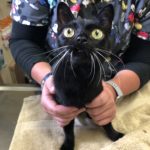Hi-
I’m so sorry you’re having such a time trying to help this cat. Has your vet ruled out everything else as far as a diagnosis? Perhaps there is something else that is worsening her initial issue? Have you tried feeding more meals throughout the day, but smaller portions? (A little at a time)
My 3 year old cat has a red bump on his arm, any ideas? He is acting normal, eating normally and doesn’t mind when I touch it. Thanks!
Comments
I have a 12 year old cat who vomits almost every day since I adopted her 5 months ago. She has been to the vet several times and a sonogram revealed she has chronic pancreatitis. They didn’t see any other issues. She was eating canned Fancy Feast with water, but now I have her on NomNomNow because I thought fresh food would help her. But she is still vomiting. It’s usually food at first but then she moves spots and vomits bile or saliva/foam. Once or twice the saliva looked bloody (took her to the vet right after). The vet had her on vitamin E, pepcid, and a round of antibiotics. Nothing helped. She has never been very playful but she is behaving relatively normally, eats, grooms, poops, etc. I don’t know what else to do! Thanks for any advice!
Comments
Hello,
1 of our 2 orphaned newborn kittens (6 days old of age) started eating less the last 12 hours. Before 3 hours I noticed his right front leg was swollen and took him to vet immediatelly. The vet said it might be broken bone or soft tissue injury but she cant tell or do anything before the kitten reaches 3 weeks. I keep the routine of feeding, cleaning + toilet. Is there anything more I should do?
Thank you
Comments
I have an 6 year old ridgeback. she had a hernia op two weeks ago. she got discharged three days after the op with drain. another three days later we took her in for a check up and and her vet wasn’t happy with a hard swelling on her abdomen. he discovered that there was a re-herniation and re-sutured. two days later she developed a seroma. she is still admitted at the veterinary hospital. is this normal healing? i am very worried. When i visit her, she is active and happy, eating well and passing stools and peeing well.
Comments
My bunny’s breathing and nose twitching is very fast. My city is in the middle of a heatwave and my bunny has recently just been laying on my kitchen tiles. My sister is staying over and she is very loud and has startled my bunny a lot. I tried to have her lay down on an ice pack but she kept trying to EAT the ice pack so I took it away. I put water in a spray and tried spraying her (it was a mist, not that much water came out) but my bunny would take one spray and run away. Her nose is twitching VERY fast and her breathing is crazy. I was wondering if there was a way I could calm her down. Is she doing OK as well? Her coat is not very thick and she is albino. Thank you.
Comments
Two days ago my 8 month old puppy had diarrhea & little pieces of his buffalo chew horn in it. I took away the horn & threw it away bc I didn’t like the fact that he was swallowing pieces. I assumed the diarrhea was from irritation of not being able to digest it. He had no diarrhea yesterday & was totally fine. This morning I woke up to diarrhea on our floor & later he threw up a small amount. His throw up had another little piece of the buffalo horn in it. He is still acting like his very hyper self & is drinking & eating like normal. My question is do you think his stomach is still just a little irritated & trying to get back to normal? Or is this something I should be really concerned about & get him seen?












Hello,
In general bumps and lumps are pretty close to impossible to diagnose with a photo. In many cases an aspirate or biopsy is needed to definitely diagnose it. My best advice is always to see your vet and inquire about removing it before it becomes a problem. Let us know what happens.